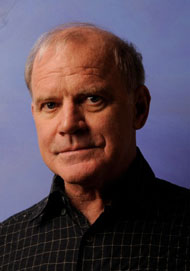Hageman Distinguished Lecturer in Agricultural Biochemistry and Provost Lecturer on Excellence in Scholarship

Dr. Kary B. MullisNobel Laureate in chemistry, 1993 October 16, 2013Lecture: "The Unusual Origins of PCR" |
About the speaker
Dr. Kary G. Mullis is an original and creative thinker. Never content to just sit and do the same thing over and over again, he has worked in many different areas of chemistry and biochemistry, from iron transport compounds to immunology. I can relate many stories about the boldness and imagination of Kary Mullis’ scientific research. He was a renegade free-thinker from the time he began graduate study in biochemistry, and the environment at UCB was paradoxical in that sense. Our mentor, the renowned inorganic biochemist Joe Neilands, was a supporter and participant in the free speech movement at UCB in 1965-1966, among many other socio-political causes that he championed. Kary entered doctoral research in 1967 and began work on bacterial compounds that complex iron in the environment; Joe’s attitudes certainly played a role in Kary’s desire to join his laboratory. On the other hand, the faculty of UCB Biochemistry were generally conservative scientific icons, known for their distinguished research accomplishments. Kary had considerable difficulty obtaining their approval of his doctoral dissertation on the structure of the bacterial siderophore schizokinen (“Schizokinen: Structure and Synthetic Work”) because he wrote such an irreverent and sometimes flippant document. You may not be aware that during his doctoral research in biochemistry Kary also published an article entitled “The cosmological significance of time reversal” (Mullis, Nature 218: 663, 1968), which preceded his contribution on characterization of schizokinen (Mullis et al., Biochemistry 10:4894, 1971). J.B. Neilands was known for his groundbreaking work on siderophores, and Mullis was a part of that with his characterization of schizokinen. After completing his PhD, Mullis tried his hand at writing fiction, and was a post-doctoral fellow at the University of Kansas Medical School, in pediatric cardiology. He also did pharmaceutical research at UCSF, prior to joining Cetus in 1979. While at Cetus trying to develop better analytical tools for DNA work, Dr. Mullis imagined the polymerase chain reaction. He then reduced it to practice and obtained patents for the idea and the practical implementations. After announcing his discovery to his superiors at Cetus, Kary was released from his job and only received a $10,000 severance check. Cetus later marketed the technology to Hoffmann-LaRoche for $300 M; Mullis received none of these monies; the ultimate financial ramifications of the discovery are so expansive that they are beyond accurate calculations. However, a decade later the Nobel prize followed. Dr. Mullis has served as a consultant to numerous research groups in many biotech companies. Most recently he has been working at a challenging project of enhancing human immunity to newly arising pathogens.
The polymerase chain reaction (PCR) definitely set off a chain reaction, an explosion, in DNA studies. It unleashed almost unimaginable possibilities in medical diagnosis now known as personalized medicine, a new and deeper understanding of evolution through unraveling the relationships between genomes of similar and diverse organisms throughout the tree of life, and a radical transformation of genetics and breeding of plants and animals. In the life sciences discoveries of the 20th century, it may stand second only to the double helical nature of DNA, and among inventions for life sciences it probably ranks first. PCR spawned techniques and patents too numerous to reliably count. Even in fields as seemingly far apart as paleontology and forensics, archeology and zoonotics, it produced radical breakthroughs, identifying long-buried kings and viruses, tracing our lineages and rescuing hundreds wrongly sentenced to prison. What a vision.
As a writer of essays Dr. Mullis touched on many aspects of the scientific and natural worlds. He has read extensively and broadly, over a wide range of disciplines. This willingness to go beyond boundaries leads to creativity. As he describes it: “Creativity .. is when you are trying to figure something out and something else keeps intruding. You finally give in to it, and it turns out to be the answer you were looking for. Perhaps something is lost and instead of looking for it, you let your hands lead you to it with your eyes closed. You might be looking something up and find the wrong subject and it turns out not only to be related, but to be exactly what you were after. It's not an accident. It was inevitable and it all makes perfect sense after the moment, but it's unexpected. That's how creativity happens. The focused beam of your consciousness is very narrow, but you have a creepy sense of what is right behind you.”